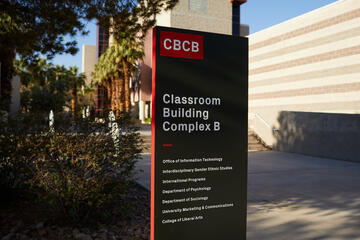Navigating a university as large and complex as UNLV can be challenging. Think back to the first time you arrived on campus. How long did it take you to find the building or facility you were looking for? Did the exterior signage stand out? Were there enough directional signs? Having good signage helps you get where you need to go quickly and efficiently and sets the tone for the visitor experience.
Enhancing the campus environment and improving wayfinding is a major component of the Maryland Campus Master Plan. Thanks to recent funding, the UNLV Planning and Construction (P&C) Department, together with Architectural Design & Signs, Inc. (AD/S), is making the campus more inviting and easier to navigate for students, faculty, staff, and visitors with the campus signage and wayfinding project.

“The campus was ready for an improved solution to our outdated signage when I started in 2002,” said John Treston, P&C executive director and university architect. P&C and AD/S are working towards removing all of the building, wayfinding, and directional signs across the Maryland campus, and replacing them with more than 300 new signs which will have a modern and consistent design to reinforce the UNLV brand.
According to Treston, signage typically does not get replaced, unless damaged or as part of a major renovation of a building. “This is why you see decades of signage around campus versus a cohesive, uniform, standard,” he said. “Signage is normally not high on the list of changes during a renovation and one of the first items cut to bring a project within budget.”
Treston says that the original “horse collar” building signage and “waterfall” building directories were “modern” in their time, but a more multi-functional, easily modifiable sign is the norm and are being installed on all UNLV campuses. “We expect signage that is interactive with artificial intelligence would be the next generation of signage.”
The new features include:


- Landmark signs. Large landmark signs will be placed at the two main campus entrances at Harmon Avenue/Maryland Parkway and Harmon Avenue/University Center Drive.
- Freestanding building identification (ID) signs. These horizontal signs will be placed at primary entrances to campus buildings. They will feature the building abbreviation in the top left corner with the full building name below. Some signs will have department(s) name(s) listed on them.
- Mounted building identification (ID) signs. These signs will be mounted next to major entry doors for on-campus buildings. They will display the building abbreviation in the top left corner with the full building name below. Some signs will have the department(s) name(s) listed on them.
- Directory kiosks. Kiosks will orient and direct visitors, faculty, staff, and students along major corridors and neighborhoods throughout the campus. They will feature the UNLV campus map in the center panel of the sign with directional arrows and abbreviations of buildings and facilities listed directly above the map as well as the neighborhood name in the top left corner.
- Pedestrian directional signs. These signs will be placed along major pedestrian routes in between kiosk locations and feature building names, building abbreviations, and directional arrows.
- Smoke-free signs. In August 2022, UNLV officially became a smoke-free campus. As part of this policy implementation, new signs will be placed both inside and outside buildings across campus starting in Fall 2023. Funding for these signs was provided by the School of Public Health through a grant with the Southern Nevada Health District.
- Vehicular directional signs. Perimeter and interior vehicular directional signs will be installed across campus. Perimeter signs will direct vehicular traffic to major university destinations. Interior signs are intended to direct vehicles through campus streets to facilities and major university destinations.



